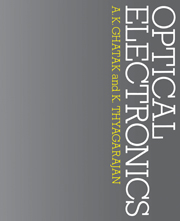Book contents
- Frontmatter
- Contents
- Preface
- 1 Maxwell's equations and propagation of electromagnetic waves
- 2 Reflection and refraction of electromagnetic waves
- 3 Wave propagation in anisotropic media
- 4 Fraunhofer diffraction
- 5 Fresnel diffraction
- 6 Spatial frequency filtering
- 7 Holography
- 8 Lasers: I
- 9 Lasers: II
- 10 Some laser systems
- 11 Electromagnetic analysis of the simplest optical waveguide
- 12 Leaky modes in optical waveguides
- 13 Optical fibre waveguides
- 14 Integrated optics
- 15 The electrooptic effect
- 16 The strain optic tensor
- 17 Acoustooptlc effect: Raman–Nath diffraction
- 18 Acoustooptic effect: Bragg diffraction
- 19 Acoustooptic devices
- 20 Nonlinear optics
- Appendices
- References and suggested reading
- Index
8 - Lasers: I
Published online by Cambridge University Press: 05 June 2012
- Frontmatter
- Contents
- Preface
- 1 Maxwell's equations and propagation of electromagnetic waves
- 2 Reflection and refraction of electromagnetic waves
- 3 Wave propagation in anisotropic media
- 4 Fraunhofer diffraction
- 5 Fresnel diffraction
- 6 Spatial frequency filtering
- 7 Holography
- 8 Lasers: I
- 9 Lasers: II
- 10 Some laser systems
- 11 Electromagnetic analysis of the simplest optical waveguide
- 12 Leaky modes in optical waveguides
- 13 Optical fibre waveguides
- 14 Integrated optics
- 15 The electrooptic effect
- 16 The strain optic tensor
- 17 Acoustooptlc effect: Raman–Nath diffraction
- 18 Acoustooptic effect: Bragg diffraction
- 19 Acoustooptic devices
- 20 Nonlinear optics
- Appendices
- References and suggested reading
- Index
Summary
Introduction
LASER is an acronym for Light Amplification by Stimulated Emission of Radiation. As the name implies, in a laser, the process of stimulated emission is used for amplifying light waves. It was as early as 1917 that Einstein first predicted the existence of two different kinds of processes by which an atom can emit radiation; these are called spontaneous and stimulated emissions. The fact that the stimulated emission process could be used in the construction of coherent optical sources was first put forward by Townes and Schawlow in the USA and Basov and Prochorov in the USSR. And finally in 1960 Maiman demonstrated the first laser. Since then the development of lasers has been extremely rapid and laser action has been demonstrated with gases, solids, liquids, free electrons, semiconductors etc.
The three main components of any laser are the amplifying medium, the pump and the optical resonator. The amplifying medium consists of a collection of atoms, molecules or ions which act as an amplifier for light waves. Under normal conditions, the number of atoms in the lower energy state is always larger than the number in the excited energy state; as such, a light wave passing through such a collection of atoms would cause more absorptions than emissions and therefore the wave will be attenuated. Thus in order to have amplification, it is necessary to have population inversion (between two atomic states) in which there is a large number of atoms in the higher energy state as compared to that in the lower energy state.
- Type
- Chapter
- Information
- Optical Electronics , pp. 201 - 244Publisher: Cambridge University PressPrint publication year: 1989



